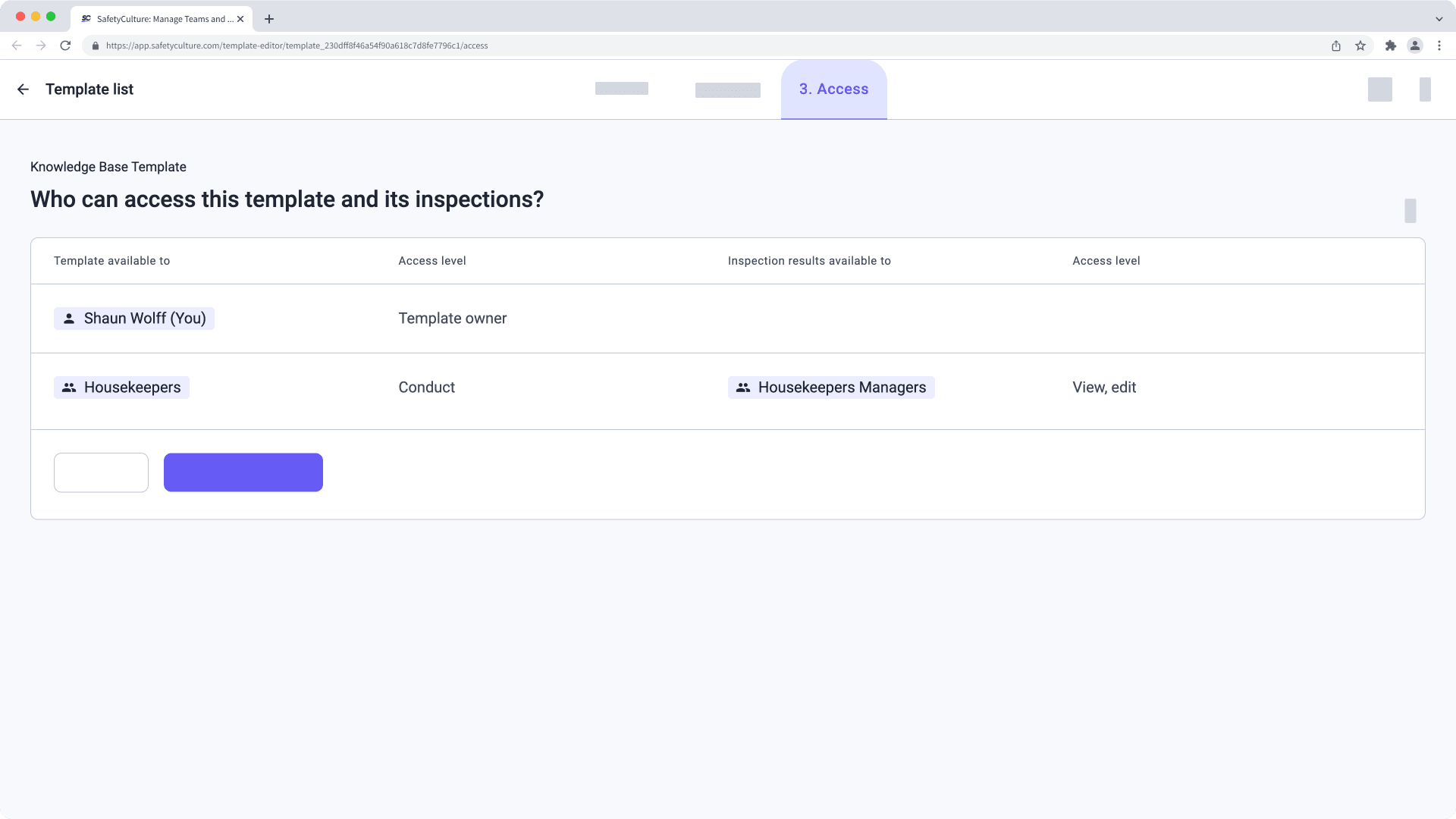- Using SafetyCulture
- Tips and tricks
- Template and inspection access: Four key questions
Template and inspection access: Four key questions
Learn about the best practices for template and inspection access and take a look at the four key questions to consider before granting access.Best practices
You should create groups even if a group would only have one user. If you give template access to a group instead of an individual user, you can add and remove users from the group without changing the access settings.
You may not want to give users or groups the "Conduct, edit" access level for a given template, as users would be able to edit the structure of the template or even duplicate it as a new one, which could often result in data access problems.
Create advanced access rules to give users template and inspection access based on their site and group membership. Like with groups, this means that you can manage site membership to dictate template and inspection access without changing the access settings.
You can manage permissions to strengthen your organization's structure. Permission management can control feature access for users in your organization, such as restricting the creation of new templates.
You should create groups even if a group would only have one user. If you give inspection access to a group instead of an individual user, you can add and remove users from the group without changing the access settings.
You can create advanced access rules to give users inspection access based on their site and group membership. Like with groups, this means that you can add or remove users from sites to dictate inspection access without changing the access settings.
In most cases, you may not want to give users the "Conduct, edit" access level or higher to each other's inspections. Think about who needs access to edit inspection results.
Four key questions
1. Who needs to conduct inspections with the template?
The first question you should consider is who in your organization needs to conduct inspections with the template. The answer to this question effectively defines the template access step.
Remember to create and give access to groups or sites whenever possible, even if they'll currently have a single user. This allows you to set up your access rules correctly from the beginning and gives you greater autonomy when users move between groups.
2. What access level does this user, group, or site need for the template?
Once you know who needs the template to conduct inspections, you need to settle on the access level you want this user, group, or site to have. Take a look at the template access levels you can give.
3. Who needs to see the user, group, or site's inspection results?
Once the template access and access levels are set up, you should consider who needs to see the inspections conducted by the groups, users, or site members who have been given template access.
Once more, we recommend using groups and sites for this. This way, you don't have to apply changes retroactively moving forward, even if users are added or removed from groups or sites.
4. What access level does this user, group, or site need for the inspection results?
Now that you know who needs to view the inspection results, you need to decide what access level the user, group, or site requires. Take a look at the inspection access levels you can give.
Keep in mind that the user who starts an inspection is by default the "owner" of that inspection, meaning the user would have the "View, edit, delete" access level to inspections they own.
Template and inspection access scenario
Here, we use a template titled "Daily Room Check", owned by Shaun Cole, to demonstrate the four key questions in action.
1. Who needs to conduct inspections with the template?
Shaun wants users Craig and Bethany to be able to complete inspections on this template. Additionally, Craig and Bethany both require the same access level. It would be a good idea here to create a group.
In this example, Shaun has created a group called "Housekeepers" and added Craig and Bethany to it. He then gave template access to the group.
You'll notice that these users appear under the "Template available to" column as a result.
2. What access level does this group need for the template?
Shaun wants them to be able to conduct inspections but not make changes to the template.
Because of this, Shaun has given the group the "Conduct" access level.
3. Who needs to see the group's inspection results?
The managers in Shaun's quality department need access to inspections conducted by the "Housekeepers" group. This department consists of three people. Mike, Emily, and Charlie. Additionally, they require the same level of access to the inspection results.
Therefore, Shaun has created and added them to a group called "Housekeepers Managers". He then set the group to automatically receive inspection results from the "Housekeepers" group. Because Shaun would like the inspections conducted by the Housekeepers group to be visible amongst the group, "Housekeepers" has also set been set to automatically receive the inspection results.
You'll notice that these groups appear under the "Inspection results available to" column.
4. What access level does this group need for the inspection results?
From time to time, the "Housekeepers Managers" group may need to make minor changes to inspections, but not to the extent of deleting inspections.
In this case, Shaun has given the group the "View, edit" access level.
Take a look at the access structure based on Shaun's scenario:


Now that you've decided on your access structure, you can learn how to give template and inspection access to groups and users in our step-by-step guide.
Was this page helpful?
Thank you for letting us know.